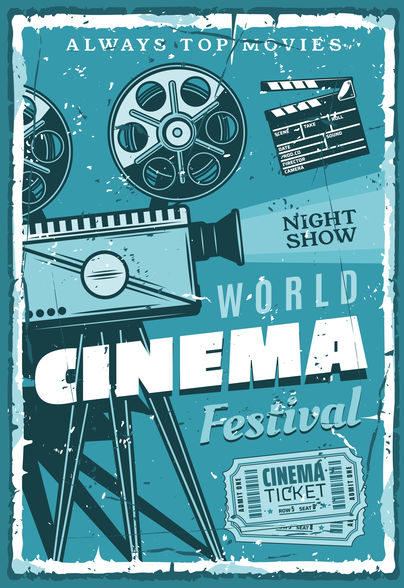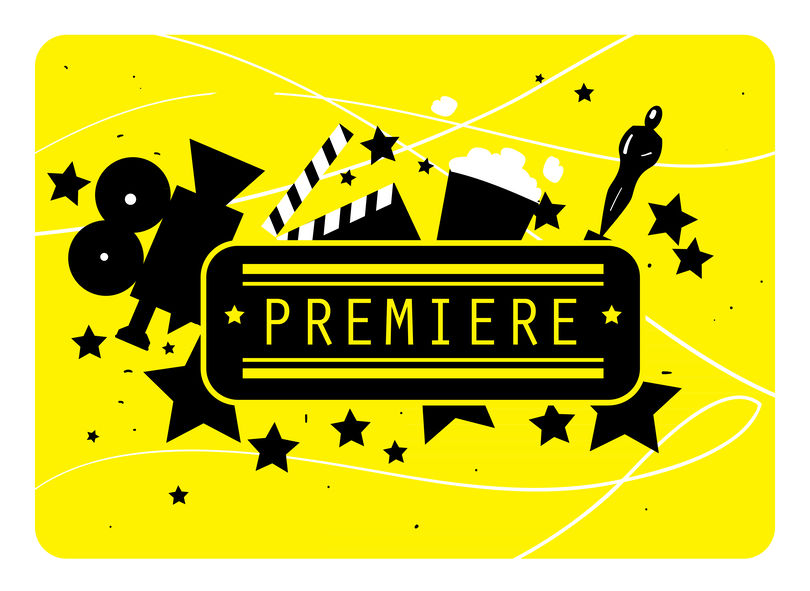As a filmmaker of any kind, you’ve probably wondered about film festivals and how they work.
No matter what country or city they are in, film festivals are events that are for screening films.
Whether its feature-length film premieres, blocks of short films united by similar themes or genres, or television and web series screenings airing new pilots, every film festival has a unique program with a unique slate of films to screen for audiences.
But how do you get your film into a film festival? What’s the submission process like? And in a world where you can apply online to any film festival around the world, how do you decide which festivals to submit to and which to ditch?
Let’s dive into this in more detail below, and also look at some great examples.
Why should you submit your film to a film festival?

First ask yourself this: Why are you interested in submitting to a film festival in the first place?
A few good reasons could be:
- Maybe you’re a longtime videographer looking to branch off and try your hand at directing and want to get your work out there for others to see.
- Maybe you’re a filmmaker looking to network and meet other filmmakers with similar tastes to work with in the future.
- Or maybe you’re an actor that is tired of not getting cast in the roles you want and so you’re producing your first starring role to show the world what you can do.
Whatever the reason, film festivals are a great place to share your work because they come with a built-in audience. A whole theater full of movie-goers will be sitting down to see your film.
Plus, outside of places on the internet like Youtube or Vimeo, film festivals are one of the only places you can go for a built-in audience to see short films.
– Not that shorts are the only film projects in competition, but they are one of the most common for first-time filmmakers.
First step: Is your film a good fit for a festival?

The first important thing is to decide if the film you are making (or have already made) is a good fit for the festival circuit in general.
Film festivals, as you will soon find out, can be very particular. While each festival is unique, they all share similar sensibilities in that they look for similar types of films they like to program.
Let’s take three of the biggest name-recognition festivals into consideration: Sundance, South by Southwest (SXSW), and Tribeca. All three are some of the most competitive and prestigious film festivals out there.
But all three, individually, are all very different.
So how do you know which to submit to?
What type of film did you make?
Before you can decide which film festivals to submit to, it’s important to determine what type of film it is, as that will help you determine the best route forward for your specific project.
There are many different types of film projects you can create, and they can be categorized by film format like length or more tonal elements like genre.
In evaluating your film, you should also consider what niches your film falls under. Does your film have any unique angles to it for marketing purposes?
Important rule of thumb: different festivals take different submissions in different categories.
Different film festivals are looking for different material. This is no mystery – if you do a little digging online, you’ll be able to find out exactly what type of films each individual festival is looking for. But not every festival is looking for material in every category.
This is why, once you define the type of film you have to submit, you need to…
Do your research

Research what types of films each individual film festival takes before you submit. In the same way, you wouldn’t want to submit a horror movie expecting to open Sundance (unless you’re A24), you wouldn’t want to submit a hard drama to a genre festival that focuses on sci-fi thrillers.
Some festivals are very on the nose about what type of films they focus on. Some are strictly genre festivals, while others feature more of a wide and eclectic spread that is harder to pin down. That’s where the research comes into play.
One of the best ways to learn what festival is best for your film is to look up what types of formats and genres they accept.
What is the format of your project?
The most common format of film submission for you as a first-timer is probably going to be a short film. Meanwhile, a more established filmmaker might be submitting a feature film.
There are also documentary, music videos, web series pilots or full web series, TV series episodes, and even commercials, all of which are potential project types you can submit to various festivals depending on their rules and submission guidelines.
As an example, not all film festivals accept web series content, but most of the ones who do accept web series submissions will ask for at least 1-3 episodes.
What genre is your film?

Defining a film by its genre is another way to decide what film festival to submit to. Almost all film festivals accept the broad categories of drama and comedy, while some specific festivals are designed around a more narrow genre in particular, like horror or sci-fi.
These more specific genres are more loosely referred to as genre films.
Genre films, while a lot of fun, are not a good fit for a more prestigious film festival like Sundance that is looking more for a well rounded artistic statement or hard-hitting drama. If you have a genre film, you might want to try something more like Slamdance.
It’s not that Sundance never accepts genre films – it’s just more unlikely given their past programming, which is true of a lot of the top festivals. It’s not impossible – just harder.
What niche is your film?
Lastly, it’s important to consider what type of niche categories your film falls into. Niches can be anything you can use to market your film, usually based on the subject matter of the film itself.
Niche categories are different than the genre of the film and cover a broad range of topics. Everything from time period to stylistic choices to the subject matter in the film could qualify.
Topics that are socially relevant or culturally specific are all possible niches. Even aesthetic achievements could be used to promote your film to specific festivals. Stories told by and featuring minority and marginalized communities are also popular niche categories.
Your film could qualify for an LGBTQ category if it features LGTBQ characters, or qualify for a new media block if it features a podcast or comic book tie in.
If it’s serialized, it could qualify for a web series block or as a standalone short depending on how you break it up. And this could all technically still count for the same film!
Speaking of genre. Check out these five pro tips to get your film selected for a film festival by Anthony Straeger – the director at Berlin Sci-Fi Filmfest.
A case study featuring a film about an orgy… seriously!
Here’s a fun story:
A filmmaker friend of mine once made a raunchy 18-minute dark comedy about an orgy gone terribly wrong. The film was considered “long” at 18 minutes, which led to it being hard to get placed in any of the bigger festivals (we’ll get into optimal film lengths a bit later).
Not only that – since a lot of the bigger, more prestigious film festivals tend to prefer dramas, it would have to be a near-perfect film to be in the running for a lot of the top festivals. While there’s less competition in comedy, they also get accepted at a much lower rate.
Remember: If you have a drama film, you’re going to face a lot more festival competition overall.
Keeping with the above example, in order to stand out, my friend decided to focus on what was unique about the film: its tone as a dark comedy and its subject matter about sex.
By honing in on these two niches, they could focus their submission efforts on comedy and dark comedy festivals to maximize the film’s festival acceptance success rate.
See, when you hone in on a single niche, it does tend to limit your submission options.
Your Film will probably be a fit for multiple niches

Luckily, most films will technically fall into multiple niche categories. For example, my friend’s film qualified as both a dark comedy and sex comedy, which helped the film’s placement across multiple festivals.
In researching festivals to submit to, my friend found the program blocks from a previous year for a festival called deadCenter based in Oklahoma City, Oklahoma, which was also listed in MovieMaker magazine’s list of the top 50 film festivals. One program block, in particular, caught their eye: Love, Sex, and Death Shorts.
Since the film was a dark comedy about sex, this block seemed like a perfect fit, and lo and behold, the festival accepted the film with open arms.
You can also follow this same logic when submitting your own films. Look up the content blocks from previous or upcoming programs to get an understanding of what types of films the festival is looking for. Look at old programming of past festivals to see if they accept films like yours.
Also learn the difference between a film festival that is genuinely supportive of a particular genre or format of film versus those that just want to include a category just to cover their bases.
Let’s say you are submitting a music video to festivals. Look up which festivals are actively promoting music and music videos versus those that just have a music video category. By submitting to the former instead of the latter, you’ll have better success in promoting your work.
FilmFreeway is a great resource for this! You can sort the festivals you are interested in submitting to based on categories like Most Popular, Academy Qualifying, niche or genre at the top of the webpage and use them to find festivals that fit your requirements.
Another way to research – find films you like online and write down where they’ve screened
You might already be doing this, but it’s worth a mention: watching short films on Vimeo is a great way to keep up to date on new and creative work from your peers – and it’s also a good place to discover films that are similar to yours.
This can also help you as you’re researching which festivals to submit to.
Let’s say you see a great film about a man and his robot living out on a farm. It’s tonally very similar to another kitchen sink sci-fi short you just made about a woman and a robot living in…the woods.
Check Vimeo (or even Instagram) to see if the film has played at any festivals, and if so, write down which ones and add those to your submission plan.
Next up: Set your schedule with a calendar of deadlines

The next thing to keep in mind when submitting to festivals is that they have submission deadlines.
In 2020, film festivals are happening almost year-round, and with the help of programs like FilmFreeway making submissions to festivals easier than ever before, there have never been more festivals to submit to than right now.
In order to maximize your efficiency and submission success ratio, you’ll want to create a calendar with all the festivals you are interested in submitting to and the dates of the deadlines when their submissions are due.
Now, festivals have a system of rolling submission deadlines. There’s almost always an early submission deadline, then a regular submission deadline, and then a late or really late submission deadline. And of course, which each subsequent deadline, they get more expensive.
So the goal with this calendar is to set yourself up for success and meet as many early deadlines as possible. And don’t forget to take your film’s premiere status into account.
Premiere Status

The premiere status of your film refers to who has seen your film before. For example, if your film gets accepted into Sundance and they are the first festival to pick it up, it would be the world premiere.
But if Tribeca picked it up a week later, it would no longer be as a world premiere. However, it technically could be a regional premiere.
Regional premieres are a premiere based on a specific region – so if you got into a film festival in a certain region, like a southwest state, it could be a southwest premiere instead of a world premiere.
In the case of some bigger film festivals, like SXSW, they only accept world premieres. Others do accept regional premieres. Like if your film got into the Seattle International Film Festival, it could be a Northwest premiere. If you get into Tribeca, it could either be an East Coast or even a New York state premiere.
Suffice to say, your film will have more of a shot at the festival if it is a “premiere.” Festivals appreciate it, and just like the news media, if they think they have something exclusive, you have more of a chance of getting picked up.
A world premiere is the most exciting to larger festivals. But regional premieres are still valued, especially if a film is good enough that it would place in a lot of festivals. There are also international premieres, which counts anytime your film plays in any country outside of your own.
At the end of the day, you can probably get away with giving each festival at least the state-level premiere status. Some are big enough to demand world premiere, but most will usually accept the state premiere status if they really want your film.
But this means you need to plan it out in advance so you’re only applying to one big festival per state when you start out!
How to plan around premiere status

Because premiere status is important to get selected, it’s important to consider when you first plan your submission schedule.
For example, if a small festival is the first one to select your film and premieres your short, other, larger festivals won’t be as excited to pick it up.
That said, if a larger festival like SXSW picks up your short, it adds credibility to your film that other, smaller festivals can latch onto as reasons for selecting your film over someone else’s.
In order to plan around this, luckily almost all festivals tell you their premiere status requirements on FilmFreeway. If you can’t find them, check their website directly. In a worst-case scenario, email them directly.
Emailing festival programmers is a good tool to get in front of them. Some might oppose this advice, but if you go about it the right way, you’ll get more positive interactions than negative.
Let the programmers know what the premiere status is of your film and include a brief and interesting fact about your film, like if it’s starring a big-name actor or something about the film that’s never been done before – which is also information you would use in a cover letter.
This will keep your submission top of mind and get them interested to keep an eye out for your film, and it lets them know you are considering them for your film’s premiere.
Putting the (submission) plan into action

So here’s what we recommend:
Make a list of your top festivals to submit to (based on your film’s specific niche categories).
Have your film finished at the end of summer to hit as many early bird deadlines as you can. Sundance is usually July through September (as of the 2020 run).
If you have self-evaluated your film to be high quality and competitive enough to be worth submitting to the biggest festivals, apply to the top film festivals first – this doesn’t have to be the big three, but the biggest ones you would want to premiere your short and that you feel you have the best chance of getting into.
Don’t apply to everything at the same time – this is an investment so save your money to see how the first couple submissions play out.
If you’re smart, submit in a tier system and go down the list from highest prestige to lowest – and don’t apply to festivals that would be a conflict of interest with another potential festival’s premier status!
If you’re applying to the big three, SXSW, Sundance, and Tribeca, you’ll probably have to wait until February to determine your status to hear back, but that will give you a sense of what will be your premiere.
But there’s plenty of amazing film festivals other than those to consider, which is why you need to do your research to find the right festival for you.
If you’re aiming big, don’t get discouraged if you don’t get in. You might get rejected more easily, but that’s okay – competition is fierce, especially in the drama category.
To put it into perspective, check out how many submissions Sundance gets a year – something like almost 13,500 film submissions, nearly 8,700 of which are short films.
Go down the rest of your list and try the others until you find the first or second-tier festival that will premiere your film. That will then determine where else you submit to – trickling down to smaller festivals.
Find a timeline where there are a few good festivals, aim to land those, and let that timing determine your run. If you don’t get into those then you can plan to either go wider or go smaller.
What else (besides your film) do you need to submit?

Here’s everything that goes with the submission:
First of all, your film. Hopefully, you have that!
Secondly, you will also need a press kit, which is a deck of material about your film that would be distributed to the press covering the festival. According to this piece on the subject from Lights Film School, this would include:
- A synopsis of the film (sometimes multiple versions at different lengths).
- Filmmaker Bios for the above the line creators (director, writer, producer, etc.)
- Actor Bios for the lead talent in the film.
- A fact sheet about the creative team and technical specs like film length, length of production, who did what, etc.
- High-res stills from the film and behind the scenes stills from the production.
- An artistic statement about the inspiration for why you chose to create this film.
- Contact info for a follow-up interview.
- Any other relevant documents to grab the attention of the media.
Most film festivals ask for press kits because they use the material you provide to promote your film and the festival itself as a whole. Journalists will also use this information to write about your film if they are covering it.
One thing to note when providing bios – include the background of your team! Smart filmmakers have diverse casts AND diverse crews, so mention it in your bios, because film festivals will ask. So genuinely be a good person and work with lots of diverse talent and team members!
Lastly, there’s the cover letter.
Cover Letters

Should you include a cover letter, especially when submitting through FilmFreeway? Yes, absolutely and always!
Most people think programmers aren’t looking at cover letters. While some won’t just based on the sheer number of submissions they receive, we do know first hand from programmer feedback that a lot of them do read the submissions.
That means two things:
- You want each cover letter you write to be as specific to the festival as possible.
- You want to provide a couple of key lines with specific pieces of information – but keep it short.
So what do you put in the cover letter? The ideal is to come across as approachable, excited about their festival, eager for the opportunity – but not desperate.
You should also include a bit about you, and what the premiere status will be (be specific – if it’s state premiere, say that). If you already had a World Premiere, tell them a regional status. If it’s not a premiere – don’t mention your premiere status if you can’t give them one.
If you did have another premiere at a noteworthy festival, you can mention that you screened there – but if you mention you already played at 20 other festivals, they’ll probably ignore it.
Then, tell them a little about your film. Include the logline of course, but also why your film is unique. To borrow a term from silicon valley and the tech world: what is the unique value proposition of your film?
An example: if your short film featured the same story and technical achievements of the film 1917, you could say, “My film is a personal tale based on my family’s history during World War 1, and told in a real-time point of view with long takes that look as if the film is entirely one shot.”
Lastly, don’t forget: include why you like their festival for your short film. In the case of my friend’s dark comedy film, you would write something like: “I saw your festival screens dark comedies. I love that because my film is a quirky dark comedy about an orgy gone wrong-”
Actual last point: keep it short! Four lines and a thank you. That’s it. Keep it bullet point length – remember, these programmers are reading tons of submissions.
Emailing the programmers
Once you submit, it’s worth reaching out to the programmers directly. Find the programmers of the festivals you are submitting to through friend connection if you can. It’s a people business, so use your connections.
Do so by showing your friends your short so they can become your evangelist. They’ll even make the intro on your behalf because it will make them look good – as long as your film is good.
How much should I expect to spend?

Film festival submissions do cost money. They are an investment to a certain extent, so don’t throw money away without doing your due diligence. That’s why research is important!
The average cost per film festival submission is usually about $30 – $60. You can save a lot of money by taking advantage of early-bird deadlines, so make your calendar early and stick to those deadlines.
The bigger, Academy award qualifying festivals are pretty pricey – definitely more on the expensive side. It would be smart to work up to those more prestigious festivals. It’s probably not a good idea to submit your first film ever to Sundance. It’s almost like throwing money away.
This is where it’s important, to be honest with yourself. Get honest criticism from people. Honestly assess the quality of your film. What type of festival do you think your film could get into? Apply to those!
Per an average festival run, submitting to as many festivals as is reasonable, you can expect to spend in total somewhere between $500 to $1000-$1200.
If you are raising money for your film, it might be a good idea to consider these costs upfront and include them in your raise, but at the bare minimum, really take into account if a festival is worth it before you submit!
That said, if you are submitting en masse, take advantage of the FilmFreeway gold membership! It has saved some of my friends upwards of $200-$300 on their festival run.
What to do if you don’t get in

Quit, leave LA, and get out of the way. …Just kidding!
If you don’t get in, remember: it’s not you or your film. Pick yourself up, because there is a festival that wants your film, you just haven’t found it. It just wasn’t right for THAT festival so don’t have an ego about it.
Just because you don’t get in doesn’t mean your film is bad. It all depends on the program and what else they have for each block. Sometimes there’s too many similar films or too many of the same length.
The way festivals put on screenings is all about curation. They sell screening blocks based on genre or niche topics, like the Love, Sex and Death block that was mentioned earlier. And remember, if your film is a drama, you are competing against all the other dramas out there.
“Drama block 8?! How the hell do they have so many drama blocks?!?”
Instead, try to strategize a bit more. Is there something unique that puts you in another category? Push your niche the next time around!
At the end of the day, if you’ve asked yourself honestly about your film, and asked your friends for honest feedback, and you still feel confident in your film, then it’s okay.
Maybe you were shooting too high or too low? Check on other submission processes. Do you need to submit to more festivals? Did you just submit to one? Did you submit to the wrong ones? What about the length of your film? Was it too long for festival programming?
If your film is over 12 minutes long, it might be too long for festival programmers!
There are so many reasons – down to the film itself. If you don’t get in wherever you apply, try learning from your mistakes and making another film to try again!
What to do if you DO get in

It means the festival wants your film! But here’s where it’s important to be just as critical of the festival accepting you as they were of your film.
Be honest. Is screening at the festival you just got into going to keep you from getting into another festival? If so, hold out before saying yes right away.
Remember, it’s an invitation – not an obligation.
If you do decline or pull out, just make sure to let them know ASAP. If you don’t give them enough notice to replace your film, you WILL burn those bridges and be blacklisted from that festival. Even that can be okay sometimes. You just have to weigh the odds.
The Online Film Festival Database

If you are looking for a resource to help you track all of the current film festivals across the country based on location, try using this online Film Festival Database.
Below you will see a screen capture of their interactive film festival map, which you can access directly HERE.
You can narrow your festival selections based on a niche topic, like women’s, LGBTQ+, animation, genre, ethnicity or culture, or whether you are looking to submit a short or documentary.
I got into multiple festivals… So do I go to each one?
Do you go or not? If you’re asking yourself that question, I give you this advice: only submit to festivals you care about going to. If you’re not planning on going, then you have another separate and really good reason to submit.
Do they offer award money? Or a cool reward to meet producers in LA? Will it do a lot for your reputation by getting in?
I could see making the argument to apply to high-quality international film festivals, even if you can’t get in, because it can expose you to new audiences.
That said, though, the whole reason is to go! If you’re a Danish filmmaker making a short film and want to submit it to American festivals, do it! But what would be even better is having a plan to actually come out to the U.S. to attend the festival to take advantage of those new audiences.
Just make sure the festival is big enough to warrant the plane ticket and lodging costs while you’re out here or you might feel very disenchanted with the whole process. That’s why you need to do your research before submitting!
I’m at the festival… how do I make the most of it?
First, a disclaimer: no one is going to buy your film. Unless you’re at a film market, but even then… compare the 13,000-something submissions to the 13-something films that got picked up by big studios at Sundance this year and your chances are put into a pretty bleak perspective.
The whole reason you are going is to network. You are there to find your people and tell them about your film, but in a way that is respectful and natural and not at all sales-pitchy.
Networking isn’t easy or fun for anyone. No one likes it but it has to be done. As uncomfortable as you are, the people you are approaching are just as uncomfortable receiving that approach. But that conversation is why everyone is there. Once you are in it, you’re in it.
A second disclaimer: Remember that everyone is there to party and have a good time. If you keep that in mind, networking doesn’t have to feel like a dirty sales call. It can feel like what it is – just hanging out and getting to know people.
How to Network like a Film Festival Pro

The biggest turn off is someone approaching you with an agenda. If you start elevator pitching yourself the second you meet a contact, you’ve already lost.
For example, if you introduce yourself to someone and they say “I’m a producer at HBO” – don’t pitch them!! Take a deep breath, relax, and instead, talk to them about the universal human condition of the experience you are both in before you jump into the pitch.
Be a good human and talk to them about the shitty alcohol. Ask them why they’re here, or what they think of everything so far. What’s been their favorite film? Block? Or anything else under the sun.
Once you’ve connected naturally, you can relax and let them know what you do. If you can, get their business card, and give them yours. Remind them who you are and invite them to come check out your film.
If someone doesn’t have time, be a kind smiling face, and simply exchange contact info after offering yours and send them a screener of your film! The easiest way to share screeners these days is via private links on Vimeo or Youtube, so keep the URLs handy to text or email.
That said, make sure you get theirs as well because if you just give them your card, they definitely won’t get back to you. You need them more than they need you!
Another pro tip: network with the programmers!

The programmers, while few, are actually one of the most, if not the most valuable connections you make at these festivals.
When you get into a festival, find out who these people are and go and THANK THEM!
After all, they are the reason you are there in the first place. They saw something worth sharing in your film, and they’d like to talk to you about it. Even if they’re shy or awkward, it’s always good to build them up. They should appreciate your appreciation as well.
Tell them they have good taste – they picked your film after all!
The most pro tip of all? Network with other filmmakers!

You’re not just there to find buyers to make your dreams come true. It just doesn’t happen that way.
Instead, reframe your brain: you’re actually there to meet other filmmakers who you will work with in the future. How do you connect with other filmmakers? Go see their films!
If you become their biggest fan, there’s a good chance they’ll become your fan, too. Get excited about what they’re going to make next.
Remember: You’re not meeting the person to buy your feature. You’re meeting the group of people who you will run into and hang out with at your next year’s festival run.
I heard the best advice: Film festivals are summer camps. You’re there to make friends, and maybe if you get lucky, you find a cheerleader to help you down the line.
Believe it or not, you actually end up making so many more friends from film festivals than from film sets. When you run into them again at another festival, you’ll be more comfortable hanging with them.
One of the first things my friend asks when he finds out if he got into a film festival is “Who’s going??” It’s good to have a contact list and reach out to other filmmakers to encourage and get each other hyped for the festival!
You’re also finding potential teammates who are in the same stage of life as you and who knows, could maybe even hire you to work on their sets at some point in the future or recommend you to that producer from HBO they met who has a project that’s perfect for you.
At the Festival… How do I get people to see my movie?
Invite people to your screening! There are a few clever ways to do this as well.
A lot of filmmakers use something known as a 5×7 postcard that has your film’s poster and includes your screening times and contact info on the back. But since a lot of filmmakers use these, get creative!
For example, one of my friends used floppy disks to get people hyped on his period 80s dark sci-fi comedy about AI. And if you’re wondering if it’s the same filmmaker who made the dark comedy about the orgy, you might be correct!
Also, don’t forget: there’s almost always a Q&A! Prep for it. Expect it.
One of the top questions that’s always asked: “What was the inspiration for your film?”
Have a good answer to this. It doesn’t have to be super deep – it just has to appeal to the basic human condition in all of us. You can be honest, but make it a story. A short story. But you’re a storyteller, after all, so don’t just go up there and say “I wanted to make something cool.”
Obviously!! So do we all!
If you have a big actor, they’ll almost always ask you how you got that person. You can tell them, but be respectful of the talent who donated their time to your movie.
Don’t say “oh just reach out to them! They’ll do anything!” Great, now that person will have a bunch of hungry filmmakers emailing them query letters all day 24/7! So much for working together again.
People will also likely ask how much you made your film for. No matter whether your budget was high or low, do not answer that question. Regardless of your answer, someone in the audience hearing that now thinks of you differently. Find a graceful way to dodge this one!
Even if you are impressed with what you were able to accomplish with your budget, it’s always better not to go there. Instead, answer how hard you worked on it or tell a fun production story – always good to have fun production stories at the ready for the Q&A!
Last Question: Are film festivals really worth it?

Yes – with a few caveats. First of all, any experience you participate in is all about what you make of it. That’s 100% true of film festivals.
This industry is who you know, and you can only know so many people. Attending film festivals is an easy way to get to know more people.
You’ll also see films you would never have seen anywhere else. And these films will inform you of what you want to see.
You will get good inspiration and bad inspiration. For better or worse. You might see something amazing and say “wow! I want to make something like that!” Or you’ll see something amazing and go “That’s it. I quit! I’ll never make something that good!”
But hey – you didn’t sign up for a “safe and stable career” (cough cough) in the film industry just to quit, now did you??
And last but not least, regardless of how well your film plays, or who you meet, or what opportunities do or don’t present themselves to you, the number one way to make a film festival really worth your while is to have fun!
You might also like this review of the book An Independent Filmmakers Guide to Preparing and Submitting to Film Festivals.
I know it sounds cheesy, but it’s important to remember that the goal of these festivals is to put on a good show and have a good time.
If you go in with the mentality that whatever festival you’re going to will be a lot of fun, then you will be more likely to actually have a good time. And that alone should (hopefully) be worth the price of admission.
And that’s it! That’s everything you need to know about film festivals, from submitting to attending. Let us know if you have any questions or feedback in the comments – especially if this article ends up helping you get into a film festival!


Dear Grant,
Thank you for this very clear and helpful article. I made my third short and soon I’ll send it to festivals as I did for the the first two shorts. This time is little different because I’m busy with other projects and I was wandering if ther’s an agency or some qualified people who can do the submission process. I produced my film also so I need some help:)
Please let me know if you have any info. Best, Maria
I need guide from you about short film.
Hi Jack,
We have created this article on the basics of creating a short film:
https://filmdaft.com/eight-steps-to-making-a-short-film/
And then we have this guide on how to write a short film:
https://filmdaft.com/how-to-write-a-screenplay-for-a-short-film/
Check out both of these and reach out again if you have further questions. We can either answer them here in the comments, or if they are important enough, we’ll write another article on that topic in particular!
Dear Grant,
My name is Maria Politano, I’m an actor and a filmmaker. Apologies, my previous message was sent incomplete.
Best,
Maria Politano
Hi Maria,
Jan (who runs FilmDaft) and I both agree the closest service to what you are talking about is filmfreeway:
https://filmfreeway.com/
You can use it to browse festivals, submit one single application, and apply to as many festivals as are available on the company’s website. You will still have to fill out everything once, but being able to fill out one application, as opposed to one hundred, is certainly a time-saver. Hope that helps!
Excellent. What do you do about second tier festivals, do you just apply to Sundance etc in 2022 and start with telluride etc in 2023?
It depends on how confident you are in your film. For example, if its your first film, I would not start with Sundance. I get that Sundance is the dream, but you’ll probably waste your money – and a chance to screen at another second tier festival that would actually accept you if you submit to it instead.
Then, it depends on your budget. As I mentioned above, if you have $500-$1200 budgeted to submit to many festivals, you can submit to both and plenty more. If both accept you as a premiere, then go with the one with the higher level of prestige. If neither accept you, then hopefully you submitted to additional, smaller ones as well.
But just because you have the budget, doesn’t mean you should apply as many places as you can. This goes back to your confidence in your film – let’s say you have the budget, AND you’re confident in your film – have you screened it to five friends who will give you honest input? Have you watched previous qualifying films to make sure you production value is of the same caliber of what’s been programmed before? If you do all that and still feel confident, then of course its worth it to take the risk and apply to Sundance, Telluride, and wherever else.
If you haven’t done that, or have and determine the film is still good but not of the caliber of Sundance, then I would suggest you apply to second tier festivals instead – and many of them. These “second tier” festivals (and I put it in quotes here because they are still awesome festivals, they just aren’t Sundance) can be great networking opportunities as I mention above, and are how I met some of my best filmmaker friends.
In conclusion:
1. Assess quality of film with one on one screen tests.
2. Watch previously programmed films and determine level of production value / quality is similar.
3. Consider budget, and prioritize festivals based on their importance to you and your chances to get in. (For instance, unique blocks of niche topics that match your film as mentioned above)
4. Apply to all of the festivals that match the above criteria and budget.
5. No need to wait another year on the same film – make another film instead!